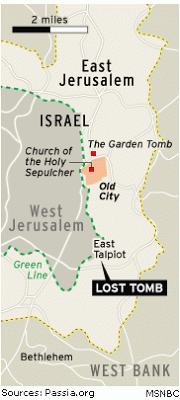The James Ossuary:The “James son of Joseph brother of Jesus,” ossuary is mentioned in the documentary:
“Forensic testing of the patina on the Jesus ossuary and that of James conclude that they came from the same tomb seemingly proving the authenticity of the often-questioned James ossuary and further increasing the likelihood that it is the tomb of the holy family.But there is one wrinkle that is not examined in the documentary, one that emerged in a Jerusalem courtroom just weeks ago at the fraud trial of James ossuary owner Oded Golan, charged with forging part of the inscription on the box. Former FBI agent Gerald Richard testified that a photo of the James ossuary, showing it in Golan’s home, was taken in the 1970s, based on tests done by the FBI photo lab. The trial resumes tomorrow.
Jacobovici conceded in an interview that if the ossuary was photographed in the 1970s, it could not then have been found in a tomb in 1980. But while he does not address the conundrum in the documentary, he said in an interview that it’s possible Golan’s photo was printed on old paper in the 1980s.”1
Moreover,
“Archaeologists also balk at the filmmaker’s claim that the James Ossuary – the center of a famous antiquities fraud in Israel – might have originated from the same cave. In 2005, Israel charged five suspects with forgery in connection with the infamous bone box. ‘I don’t think the James Ossuary came from the same cave,’ said Dan Bahat, an archaeologist at Bar-Ilan University.
‘If it were found there, the man who made the forgery would have taken something better. He would have taken Jesus.’”2
Furthermore,
“The antiquities dealer (Oded Golan) from which the James ossuary was procured, attests that it came from Silwan, not Talpiot, and had dirt in it matching the soil from that location in Jerusalem, whereas the ossuaries from Talpiot came out of a rock cave from a different place, without such soil in it. ‘To theorize that there was a Jesus family tomb, and yet the one member of Jesus’ family who we know was buried in Jerusalem for a long time did not come out of the ground from that locale contradicts this theory.
Furthermore, Eusebius reports that the tomb marker for James’ burial was close to where James was martyred near the temple mount, indeed near the famous tombs in the Kidron valley such as the so-called tomb of Absalom. Talpiot is nowhere near this locale.”3
The Geological Survey of Israel (GSI) and the Israel Antiquities Authority (IAA) have declared that the inscription on the James Ossuary is a forgery. They also state, “the ‘letters patina’ of ‘James Ossuary’ reveals that the patina could not have formed under natural climatic conditions (temperature and water composition) that prevailed in the Judea Mountains during the last 2000 years.”4
Most noteworthy is the fact that Kloner was specifically asked,
“What of the assertion that the 10th ossuary disappeared from your care and may be none other than the ‘James’ ossuary?”
He responds thusly,
“Nothing has disappeared. The 10th ossuary was on my list. The measurements were not the same (as the James ossuary). It was plain (without an inscription). We had no room under our roofs for all the ossuaries, so unmarked ones were sometimes kept in the courtyard (of the Rockefeller Museum).”5
Of further archeological interest may be The Jesus Tablet – “L’shloshet Yamin-In Three Days” – “Sar Hasarin-Prince of Princes.
Concluding Musings:
It appears that the documentary is accurate in its depictions of actual findings:
A tomb was, in fact, found.
Ossuaries were, in fact, found.
Legible inscriptions were, in fact, found.
Very common names were, in fact, found.
– – – – – – – – – – –
Perhaps it was a family tomb.
Perhaps someone name Yeshua was married to Mariamne or Mara or Maria.
Perhaps Yehuda was their son.
Perhaps this was even the family tomb of Jesus the Messiah.
Perhaps.
The “facts” are one part of the documentary and the “perhaps” are another. It is the perhaps portions that threaten to discredit an otherwise interesting documentary about ancient history and modern archaeology. The dramatic recreations, being based on perhaps, are unfounded personal interpretations that are only an accurate representation of the filmmaker’s active imaginations.
We find the filmmaker’s irresponsible hype in his claims to have found the ossuaries of “The Virgin Mary, Jesus of Nazareth, Mary Magdalene and Judah, their son,” when, in fact, no such thing was found.
The scientific fact of DNA is less than conclusive. The statistics are questionable, at best. We are left with many unanswered and unasked questions.

